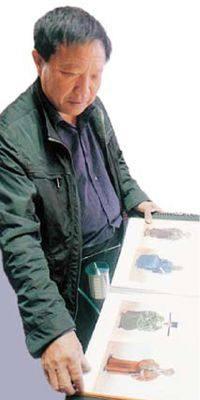蜡像塑出的传奇
2012-04-29韩笙
韩笙



在中国东南一隅的三门县里,我见到了这样一个人,他用平凡的双手临摹人的杰作,竭尽心血来换取作品的永恒。
他叫郑有严,是一位土生土长的老乡、一位因患小儿麻痹症而致瘸的残疾人、一位远近闻名的民间艺术传承者、一位成功的文化产业创业家。
在他的身上,融合了秉性淳朴、身怀绝艺、眼光独特、身残志坚这一系列特质,也给了我充分的理由去走近、去了解他的传奇人生。
才艺心:不屈于命运
不高的个子,额头上有些许皱纹,显得清癯,但年已花甲的他常露出孩子才有的纯真笑容,这是郑有严给我的第一印象。
郑有严不是一个特别能侃的人,他属于那种用作品说话的艺术家。从他不多的言语里,一个“苦孩子”与命运斗争的往事便像电影放映般徐徐拉开了帷幕。
两岁时,郑有严患上小儿麻痹症,两腿致残。从懂事起,郑有严就表现出对绘画和书法的极大天赋和热情。进入县城三门中学读书后,美术课成绩一直名列前茅。初中毕业,他跟村里老工匠学油漆、学雕花。
上个世纪80年代初期,郑有严已经是四邻八乡颇有名气的雕花匠了,同时,他也在生产大队办的橡胶厂里工作。有一次,他在县城百货公司看到穿各色服装的模特,便想到经济发展了,模特需求量肯定会大增,厂里办个模特制造车间不是挺好吗?于是郑有严张罗为厂里发展新业务——做石膏模特。
俗话说,隔行如隔山。虽然有着十几年的雕花手艺,但如何做出合格的石膏模特产品成了郑有严遇到的最大难题。正在此时,上海一外贸公司的石膏雕塑师傅郑志跃退休回乡养老,郑有严喜出望外,立刻上门求教,拜老师傅为师。由于有着超于常人的艺术天赋和十几年的雕刻功底,别人需要几年才能学成的手艺,郑有严仅仅花了三两个月时间,便完全掌握了。
从因病致残的无知孩提、懵懂岁月的求学少年、青年时期的雕花工匠,再到后来蜡塑领域的先驱艺人、江南地区首屈一指的蜡像艺术家,透着一股子憨劲儿的郑有严,内心深处其实一直都在经历着波澜壮阔的心灵风暴。人生的一切灾难、折磨和不幸都成了他日后艺术创作的深厚底蕴和艺术营养。
技术心:不放过细节
1984年,郑有严迎来了人生的第一个转折点。为展示城市浓厚的文化底蕴,杭州市委托杭州工艺研究所恢复李渔、于谦、济公等浙江历史名人雕像。研究所找到了当时在石膏雕塑业已小有名气的郑有严,一番考察后,决定邀请他参与合作。而这次合作,不仅给郑有严带来了个人荣誉,也使他正式走上了蜡像创作之路。
在那次工作中,为了提高制作模特的水平,郑有严和他的团队在科研人员的帮助下,将人物像从石膏改为蜡注,这一改难度更大,从设计、浇铸、脱模、上眼珠、修整、植毛发,到穿上各色服装等,要经过二十几道工序。每道工序又有几十道小工序。比如植发这一工序,要用针在酒精灯上烘烫后一根一根地“种”上去,需要六七天时间。
很多人知道英国伦敦有个杜莎夫人蜡像馆,蜡像制作水准全球一流,郑有严没有亲眼见过,一切从零开始。人物蜡像的塑造难度远远超出人们的想象。为了使人物形象更加逼真,郑有严倾注了自己的所有心血。在对人物眉毛的取材上,他一开始选取人的头发为原材料,但由于横截面较为明显,效果并不理想。于是,他又几十上百次尝试用各种动物毛发与不同人物进行匹配,最终才得以选定。
郑有严在蜡像创作中,还解决了从二维空间到三维空间的转换问题。我们的世界是三维的,把它画成画就成了二维。雕塑是从三维到三维,没有维度转换,相对比较容易。蜡像则不同。因为蜡像多是按照片来塑造的,被塑人物的眼皮有多厚、眼窝有多深、颧骨如何转折和过渡,很难从二维的照片上判断出来。郑有严的做法是,做完一尊头像,放在灯光下仔细端详:五官的起伏凹凸形成的阴影必须与照片相同,甚至从鼻梁到鼻尖到鼻翼的高光形状都要分毫不差!
正是由于郑有严对作品近乎于严苛的态度,让其作品渐渐进入大众的视野,也让他成为了中国最早一批从事蜡像创作的民间艺人。蜚声全球的杜莎夫人蜡像馆有着200多年的历史,而蜡像艺术传入中国,只是上个世纪80年代的事。那时候别说在小县城三门,就是放眼全国,蜡像艺术都是鲜有人知的。
事业心:不错失机遇
1987年,掌握了蜡像制作技术的郑有严“下海”创办高枧工艺美术厂,每年都有百尊左右的名人蜡像出炉。1989年,郑有严为北京民族文化宫创作了一组展示西藏和平解放40周年的蜡像,系统地反映了西藏农奴从解放到自立自强创造美好生活的进程。这组雕像不但造型逼真,皮肤质感鲜活,而且呈现出人物性格和风采,一面世便赢得了“满堂彩”。
可惜的是,当时对知识产权、非遗保护还没有概念的郑有严,更多地只是把制作蜡像当成“吃饭活计”,多年来,他靠着手艺帮一些设计院做“贴牌生产”的代工活计,没有自己的品牌。一直到2005年,浙江省文化厅一个考察组来到郑有严的蜡像制作基地,看到他制作的蜡像后,立刻被惊呆了。考察组一位负责人说:“老郑啊,你这个东西是文化产业,是一门绝活,应该走出家乡,到杭州、上海等大城市去做,把这个文化产业做大,做出档次。”
一语点醒梦中人,直到今天,郑有严还记着这位负责人的话,逢年过节都会发个短信去问候。在我的采访中,他也数次提到了这位“指路人”对自己人生的巨大意义。
2005年刚过完年,郑有严就带着女儿、女婿来到杭州,成立了怡和蜡像艺术有限公司,主要负责销售。随着市场的不断开拓,越来越多的客户要求参观郑有严蜡像的制作基地,于是,2008年,老郑把已经在高枧安家数十年的蜡像制作基地搬到了距离机场更近的萧山,注册了杭州红色源雕塑艺术有限公司。
几年来,郑有严创作了数千座蜡像,其中不乏伟人和名人:共和国领袖、科学家、艺术家、英模及历史人物,遍布于包括湖北武汉的辛亥革命博物馆、江苏南通的纺织博物馆、新疆巴州的州博物馆和绍兴的党史纪念馆等大型展馆在内的全国数百家博物馆和纪念馆中。有报道说,江浙沪地区70%以上的博物馆都有他的蜡像作品。
家乡心:不甘为游子
在三门采访期间,不少人都在交谈中表露出,郑有严把创作和销售中心设到杭州、萧山去,是三门当地经济和文化的流失,似乎有些道理。但听说郑有严亲手打造了“三门湾名人蜡像馆”,又让我彻底改变了想法。
这个蜡像馆里,陈列着与三门有诸多渊源的十位名人,分别是陈霸先、赵构、文天祥、戚继光、孙中山、梅盛、郑虔、罗适、叶兑和包定。十人中既有忠贞爱国的民族英雄、献身革命的烈士,也有隐逸的高士、三门诸多氏族的先祖,其业绩逸事至今仍被大家津津乐道。有意思的是,塑像全部由郑有严和他的团队制作,人物形象逼真。不少实地看过塑像的人都觉得,这不单单是郑有严接的一笔“生意”,那些高质量的蜡像,反映了郑有严的家乡情怀和对故土的热爱。
近年来,高枧乡大打旅游文化牌,政府希望郑有严的蜡像艺术能够重返故里。所以,郑有严就把杭州的产业交给子女打理,自己回到高枧的旧厂房,着手忙起了蜡像新馆的设计及主题展示研究。
“三门县领导对我的事业特别支持,还特地来看望我,现在我正忙着设计蜡像新馆,研究通过什么作品来展示三门的名人、三门的文化。我的旧厂房从制作基地转化为文化展示基地的条件已经成熟,我想在这几年把它转成人文景点,做成一个文化产业的展示基地。”郑有严说,“我是从三门、从高枧走出去的,现在我想回到这片土地。”□
(本文照片由郑有严提供)
Legendary Master of Wax Figures
By Han Sheng
Zheng Youyan, a master of wax figures, is a native of Sanmen County in southeastern Zhejiang Province. Born in 1949, he was crippled at 2 by polio. As a boy, he showed an unusual talent for drawing and calligraphy. After graduation from the countys junior high school, he began to take lessons of painting and carving from village craftsmen.
By the early 1980s, Zheng had long since established himself as an excellent woodcarving craftsman and he worked at a rubber factory. While visiting a store in the county capital one day, he noticed some fashion dummies. Inspired, the young craftsman believed there would be a market for dummies. The factory planned to set up a workshop to make dummies. Zheng, however, did not have any idea how to make dummies. It just happened that Zheng Zhiyue, a fellow villager who had been working in Shanghai as a plaster statues sculptor for a foreign trade company, had retired and come home. Zheng Youyan went to the master and studied. Three months later, Zheng mastered the process.
The turning point in his career as a sculptor came about in 1984 when a Hangzhou-based institute for arts and crafts began to look for a master to make statues for historical figures of Zhejiang origin for public display. The institute came to Zheng Youyan, who had already established himself as a dominant player in the field. The people from the institute were satisfied with Zhengs capability and decided to hire Zheng to make statues.
It was a huge challenge. Zheng had made quite a few plaster figures. Now he was supposed to make wax figures. Zheng had never seen any real wax figures in his life. The self-made artist experimented and tried a lot of new procedures. One of the big problems he solved was to translate photos into three-dimensional wax figures. It was impossible to figure out accurate details of eyelids, eye sockets, and cheekbones. Photos were hardly accurate indicators. His solution was to put a sculpted head under light and compare shadow and light with the same details of the face in the photo. His idea was that if shadow, light and gloss all matched, then the wax face would have to be an accurate replica.
In 1987, Zheng set up his own business to make wax sculptures. For a long while Zheng was satisfied with getting orders and deliver products. It was not until 2005 when a group of experts from Zhejiang Culture Administration came to his business in Sanmen that Zheng learned that there was more for him to reach out and get. One expert wowed, totally amazed by Zhengs expertise and wax figures and pointed out that Zhengs business looked like a total industry and advised Zheng to set up his business in Shanghai or Hangzhou.
After the Spring Festival in 2005, Zheng came to Hangzhou with his daughter and son-in-law and set up a wax-figure company. He was in charge of sales. Based in Hangzhou, he opened up a huge market. As more and more clients wanted to see his workshops close at hand, in 2008, Zheng relocated his workshops from Sanmen to a location near the Hangzhou International Airport.
These years, Zheng Youyan has produced several thousands of wax figures: politicians, scientists, artists, model workers and historical personages for museums across the country. Hundreds of museums and memorials in China have his wax figures. It is said that 70% of the museums in Shanghai, Zhejiang and Jiangsu have his wax figures.
While in Sanmen, I talked with some local people. Some of them complained that Sanmen suffered some losses as Zheng now operates in Hangzhou. However, Zheng has contributed a great deal to the Museum of Historical Figures of Sanmen Bay in his home county. I visited the museum and thought there was no loss for the county. Zheng has moved back to Sanmen as the local government hopes he would come back to contribute to the prosperity of local tourism. Now, Zheng has moved back, leaving the business in Hangzhou to his children.
At present, he is planning a new was museum for Sanmen. He thinks it is now time to transform his old factory space into a cultural complex. He wants to turn it into a base of cultural industry. □
